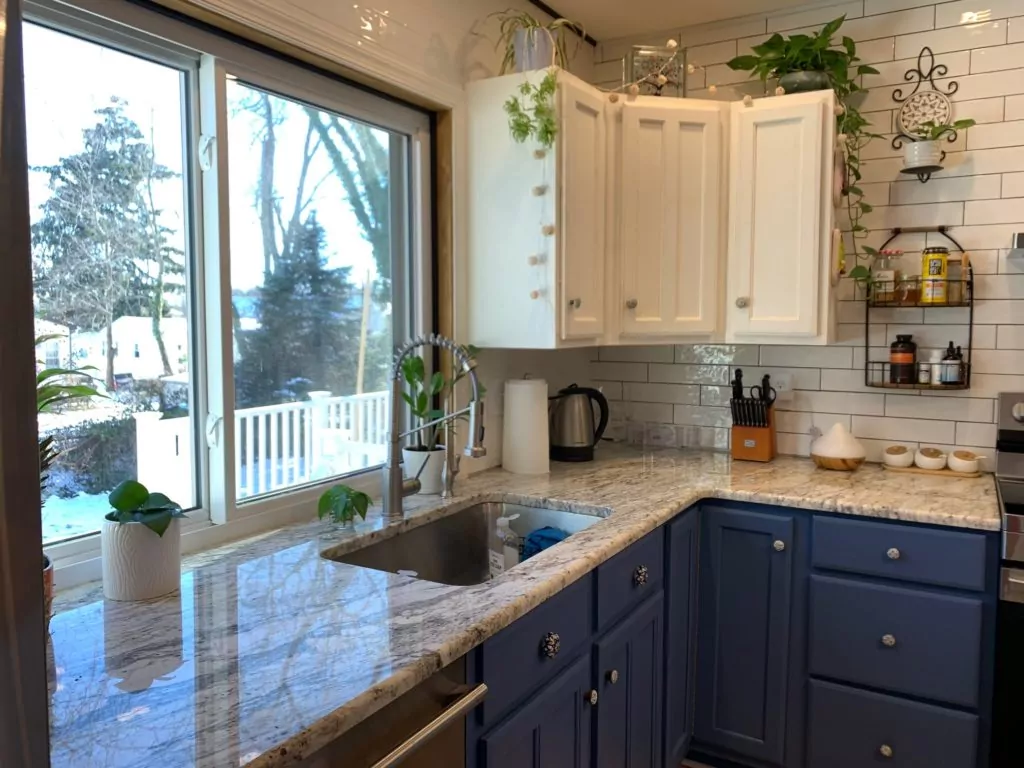When researching countertop materials, you’ve probably come across quartz and quartzite and gotten a bit confused — aren’t they basically the same thing? Not at all! Let’s check out the differences between both surfaces and figure out which one would be right for your space.
Composition and Appearance
Quartz countertops are man-made and consist of quartz chips or quartz dust bound together with resin. Usually, the composition is about 90-95% quartz to 5-10% resin. Quartz countertops made with chips have a mottled, speckled appearance since you can see the individual stones suspended in the resin. Color options here are pretty limitless, as resins can be tinted to any hue and the quartz chips can be as uniform or diverse in color as you’d like.
Countertops made with quartz dust, on the other hand, are much more uniform in appearance—more like a slate or a sandstone—as no discernible grains or individual stones will be visible. As above, the resin used to color the countertop can be tinted pretty much any color, but since the quartz is so finely ground the overall appearance and color will be very even, without much variation.
Quartzite countertops are actual slabs of natural quartzite stone. Quartzite is a metamorphic rock that starts out life as a quartz-rich sandstone that transforms under intense heat, pressure, and metamorphic activity. Over time, these factors cause the materials to recrystallize and reconfigure the quartz grains into an incredibly strong, interlocking structure.
As a natural material, quartzite countertops come in a more limited color palate than quartz, though they are often multi-hued and can have dramatic marble-like veins. In fact, this is one of the greatest features of quartzite: it gives you the look of marble, but with more durability. Generally, you can expect to find quartzite countertops in variations of white, gray, red yellow, pink, and blue. Finally, while quartz countertops by and large don’t resemble natural stone, the beauty of quartzite lies in the fact that no two pieces are the same. Your countertop will be completely unique to you, its own work of art.
Durability
Quartz countertops are very hard and durable and are resistant to chipping, etching, and scratches. However, quartz countertops are considered UV unstable, which means that they can discolor in direct sunlight. This surface can also be damaged by heat from, say, a hot pot or a kettle of boiling water, though this can be prevented by using trivets and other heat-diffusing objects. The resins can sometimes also be stained by some common household oils, so care should be taken to wipe up any oil spills immediately.
Quartzite is about as hard and durable as granite. It won’t be damaged by heat or cold, nor will it be discolored by sunlight. The surface is very resistant to scratching and chipping as well as etching which, again, makes it a good alternative to marble.
Maintenance
Quartz countertops are virtually maintenance-free. Because the quartz chips or dust is suspended in resin, it never needs to be resealed. As mentioned above, as long as you protect it from intense heat and direct sunlight and be sure to clean up any oil spills immediately, you never really have to worry about your quartz countertop being damaged.
Although quartzite countertops are incredibly durable, that doesn’t mean the surface is maintenance-free. You’ll need to reseal your quartzite periodically to prevent water from getting into the stone’s natural pores, about every 6 months to 1 year depending on how much wear and tear it gets. While this is a relatively easy process you can do yourself, some homeowners don’t like the added work and get lax with the maintenance, which can cause damage to the stone over time.
Cost
You might be surprised to know that, although they’re man-made, quartz countertops are not necessarily cheaper than quartzite countertops. For countertops without complex elements, the cost of both surfaces is quite similar, ranging from about $60-$100+ per square foot. Quartz may be cheaper for complex surfaces since it’s easier to cut and manufacture than natural quartzite, but it really depends on the work involved and the difficulty of installation.
Quartzite does tend to be more expensive than granite. However, certain slabs will very closely resemble marble in their coloration and veining, but don’t have all the maintenance issues that natural marble comes with. So, if you want the look of marble without all the fuss, the expense will likely be worthwhile.
So, which is better?
Neither! Both surfaces are very strong and durable and will look beautiful in your home for years to come. As we’ve illustrated above, there are definite pros and cons to each material that need to be taken into consideration alongside how you live and work in your kitchen. Quartzite is durable, easy to cook and entertain on, and can withstand heavy traffic. You’ll just have to commit to regular resealing to maintain the appearance and, like other natural stones, be careful not to drop anything heavy on it to prevent chips or cracks. Quartz is also extremely durable and requires no maintenance, though it can be more easily damaged by heat, natural light, and some oils.
Have you installed a quartz or quartzite countertop in your home? Tell us about how you decided in the comments!


